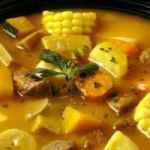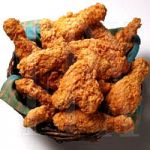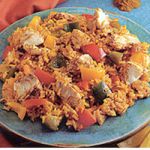 |
Dominican cooking is a cultural blend of Taino, Creole, European and African influences in an explosion of flavors rich in colors, condiments and tastes. It is above all a simple and nourishing cuisine that is not highly spiced; in fact, there is no spice market here as there is in other West Indian countries.
When it comes to meat, goat or kid is commonly used in stews - for example, chivo guisado (kid marinated in a mixture of herbs, lime juice and rum). The goat meat here has a delicious flavour since the goats graze on wild oregano. You might say the meat comes pre-seasoned! Beef (res) and pork (cerdo) are also common.

While Dominicans love long-simmered dishes, they also adore fried foods like pastelitos (little turnovers stuffed with beef, chicken or cheese...), platanos (plantain banana), and tostones (green plantain banana) always served at lunch, part of "La Bandera" (the flag), the traditional lunch including white rice, red beans (habichuelas) and meat.
On the seafood side, the shrimp, fished mainly in Samana Bay, is succulent. Crab and rock lobster are expensive and mostly reserved for tourists. The most common fishes found on market stalls are mahi-mahi, tuna, marlin and tazar.
Soups are made even in the poorest households and constitute a unique part of Dominican cooking. Typical is asopao, rice soup accompanied by chicken, fish or vegetables.

Sancocho is the national dish, the local take on the Spanish stew cocido. Each region has its own way of making it, but the most spectacular is sancocho prieto, which contains seven meats and is a favourite dish for Sunday dinner.

You can discover chicharones, pork rind marinated in the juice of bitter oranges and cooked in its own fat. Stop in at a pica pollo and try fried chicken prepared the local way, served with plantain. Paradas, or road-side restaurants, found along all major routes will provide you with a good local meal that you can eat on site, often in loud and colourful surroundings. Order modongo (tripe stew flavoured with lime zest), or sample fish accompanied by various garlic or lemon-based sauces or prepared "criolla" style (with pepper and tomatoes), a dish always served with rice.
Try the local specialties: Samana fish "con coco" (with coconut cream), chivo de Azua (a goat dish from the Azua region), or chivo liniero (another goat dish, this one from the northwest part of the country.)

This is the dish that you could say links the Dominican Republic to its mother country. Let's step back in history for a moment… in 1492, Christopher Columbus, thinking he had arrived in the Indies, landed on the island and named it Isla Española, which later became Hispaniola. During the period of the conquest, Spanish women who relocated here wanted to recreate the famous paella of their homeland but were forced to adapt the recipe to local ingredients. Their revamping of paella became the basis for locrio. Since there is no saffron here, the rice is coloured with achiote or annatto. This is the most versatile dish in Dominican cuisine, since countless variations are possible, beginning with just a little rice and whatever else is on hand.
Casabe, a round flat cassava bread, and catibias, cassava flour fritters filled with meat, are the only culinary legacy of the Taino Indians (the "friend people," in their language) who lived on the island from at least the 8th century. This peaceful tribe, who had advanced agricultural skills, cultivated cassava, sweet potato, beans, squash, peanuts and pineapple.

Johnny cake and Mangù, an inheritance from immigrants from the windward and leeward islands, are part of the daily diet of residents of the Dominican Republic. Mangù, a mash of boiled green bananas, is a popular breakfast dish, while johnny cake is a standard dessert. It is a substantial, nutmeg-flavored variation on pound cake. Its name derives from "journey cake," since it was the only food taken along by the early settlers when they headed out to sea to fish.
Desserts here are very sweet, made with sugar and condensed milk in various flavours (coconut, papaya, banana, pineapple, soursop, ginger), prepared as flans, puddings, creams, etc. Tropical fruits are abundant and are used in desserts throughout the year, but many different varieties are found depending on the altitude (for example, cherries, plums and strawberries grow in the central regions).

Beer is found everywhere, particularly "Presidente," but the pride of Dominican beverages remains rum. Three brands - the three Bs - share the market: Brugal (the most popular), Barcelo (perhaps the best-liked), and Bermudez (the most distinguished). As for cocktails… they're not really part of the local culture. The best and simplest cocktail is the equivalent of the West Indian ti-punch: a little dark rum mixed with sugar cane and lime. If you really want to do things Dominican-style, ask for "un servicio de ron" in a colmado (a combination grocery store-café), bar or disco: they'll bring you all the ingredients so that you can concoct your own cocktail.
We'll end with a strange little aside: the Brugal rum company is the sponsor of the country's road signs!
Thanks to Aude and Olivier Guilmain from Eva Luna at Las Terrenas for their kind assistance
Photos (Sancocho, Bandera) - Dominican Republic Ministry of Tourism
Photos (Locrio, Pica pollo) - http://www.turismosantodomingo.com/
Photo (Mangu) - http://www.dominicancooking.com

-

 Recipes
Recipes
-

 Products
Products
-

 Entertaining
Entertaining
-

 Chefs
Chefs
-

 Hints & Tips
Hints & Tips
-

 Glossaries
Glossaries








